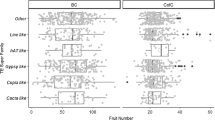Summary
In Antirrhinum majus the transposable element Tam3 has been described at two unlinked loci pallida and nivea, both of which are required for the production of anthocyanin pigment in flowers. In each case the element is inserted in the promoter region and gives a variegated phenotype. We show that the rate of Tam3 excision at both loci is greatly affected by temperature, being approximately 1000-fold higher at 15°C compared with 25°C. Tam3 is also controlled by an unlinked gene Stabiliser, which considerably reduces excision rate. We show that the high degree of sensitivity to temperature and Stabiliser is an intrinsic property of Tam3 which is not shared by an unrelated element, Tam1. The Tam3 insertion at nivea gives rise to a series of alleles which confer reduced pigmentation, novel spatial patterns and changed instability. These are probably a result of imprecise excision and rearrangements of the Tam3 element.
Similar content being viewed by others
References
Baur E (1924) Untersuchungen über das Wesen, die Entstehung und die Vererbung von Rassenunterschieden bei Antirrhinum majus. Bibliotheca Genetica 4:1–70
Bonas U, Sommer H, Harrison BJ, Saedler H (1984a) The transposable element Tam1 of Antirrhinum majus is 17 kb long. Mol Gen Genet 194:138–143
Bonas U, Sommer H, Saedler H (1984b) The 17 kb Tam1 element of Antirrhinum majus induces a 3-bp duplication upon integration into the chalcone synthase gene. EMBO J 13:1015–1019
Brink RA, Greenblatt IM (1954) Diffuse, a pattern gene in Zea mays. J Hered 45:47–50
Carpenter R, Coen ES, Hudson AD, Martin CR (1984) Transposable genetic elements and genetic instability in Antirrhinum. John Innes Report, pp 52–64
Coen ES, Carpenter R, Martin CR (1986) Transposable elements generate novel spatial patterns of gene expression in Antirrhinum majus. Cell 47:285–296
Faberge AC, Beale GH (1942) An unstable gene in Portulaca: mutation rate at different temperatures. J Genet 43:173–188
Fedoroff NV (1983) Controlling elements in maize. In: Shapiro JA (ed) Mobile genetic elements. Academic Press, New York, pp 1–61
Fedoroff NV, Wessler S, Shure M (1983) Isolation of the transposable maize controlling elements Ac and Ds. Cell 35:235–242
Fincham JRS, Harrison BJ (1967) Instability at the Pal locus in Antirrhinum majus. II. Multiple alleles produced by mutation of one original unstable allele. Heredity 22:211–227
Greenblatt IM (1975) Linkage relations of the diffuse factor on chromosome 4 and A major modifier of diffuse instability. Maize Genet Coop Newslett 49:23–27
Harrison BJ, Carpenter R (1973) A comparison of the instabilities at the nivea and pallida loci in Antirrhinum majus. Heredity 31:309–323
Harrison BJ, Carpenter R (1979a) Resurgence of genetic instability in Antirrhinum majus. Mutat Res 63:47–66
Harrison BJ, Carpenter R (1979b) Resurgent instability transposition and crossing-over in Antirrhinum majus. John Innes Report, pp 51–53
Harrison BJ, Carpenter R (1980) Instability and transposition: a) somatic mutability of the stabiliser regulating system in Antirrhinum majus. John Innes Report, pp 72–74
Harrison BJ, Fincham JRS (1964) Instability at the Pal locus in Antirrhinum majus. 1. Effects of environment on frequencies of somatic and germinal mutation. Heredity 19:237–258
Harrison BJ, Fincham JRS (1968) Instability at the Pal locus in Antirrhinum majus. 3. A gene controlling mutation frequency. Heredity 23:67–72
Harrison BJ, Stickland RG (1974) Precursors and genetic control of pigmentation. 2. Genotype analysis of pigment controlling genes in acyanic phenotypes in Antirrhinum majus. Heredity 33:112–115
Kretschmer PJ, Cohen SN (1979) Effect of temperature on translocation frequency of the Tn3 element. J Bacteriol 139:515–519
Martin C, Carpenter R, Sommer H, Saedler H, Coen ES (1985) Molecular analysis of instability in flower pigmentation of Antirrhinum majus, following isolation of the pallida locus by transposon tagging. EMBO J 4:1625–1630
McClintock B (1951) Chromosome organisation and genetic expression. Cold Spring Harbor Symp Quant Biol 16:13–47
Nevers P, Shepherd N, Saedler H (1986) Plant transposable elements. Adv Bot Res 12:103–203
Paquin CE, Williamson VM (1986) Ty insertions at two loci account for most of the spontaneous antimycin A resistance mutations during growth at 15° C of Saccharomyces cerevisiae strains lacking ADH1. Mol Cell Biol 6:70–79
Pereira A, Schwarz-Sommer Z, Gierl A, Bertram I, Peterson P, Saedler H (1985) Genetic and molecular analysis of the Enhancer (En) transposable element system of Zea mays. EMBO J 4:17–23
Peterson PA (1958) The effect of temperature on the mutation rate of a mutable locus in maize. Heredity 44:121–124
Peterson PA (1980) Instability among the components of a regulatory element transposon in maize. Cold Spring Harbor Symp Quant Biol 45:447–455
Rhoades M (1941) The genetic control of mutability in maize. Cold Spring Harbor Symp Quant Biol 9:138–144
Sand SA (1957) Phenotypic variability and the influence of temperature on somatic instability in cultures derived between Nicotiana langsdorffii and N. sanderae. Genetics 42:685–703
Sommer H, Carpenter R, Harrison BJ, Saedler H (1985) The transposable element Tam3 of Antirrhinum majus generates a novel type of sequence alterations upon excision. Mol Gen Genet 199:225–231
Southern EM (1975) Detection of specific sequences among DNA fragments separated by gel electrophoresis. J Mol Biol 98:503–571
Stickland RG, Harrison BJ (1974) Precursors and genetic control of pigmentation. 1. Induced biosynthesis of pelagonidin, cyanidin and delphinidin in Antirrhinum majus. Heredity 33:108–112
Stubbe H (1966) Genetik and zytologie von Antirrhinum L. sect Antirrhinum. Veb Gustav Fischer, Jena
Upadhyaya KC, Sommer H, Krebbers E, Saedler H (1985) The paramutagenic line niv-44 has a 5 kb insert, Tam2, in the chalcone synthase gene of Antirrhinum majus. Mol Gen Genet 199:201–207
Wienand U, Weydemann U, Nierbach-Klöngen U, Peterson PA, Saedler H (1986) Molecular cloning of the C2 locus of Zea mays, the gene coding for chalcone synthase. Mol Gen Genet 203:202–207
Author information
Authors and Affiliations
Additional information
Communicated by H. Saedler
Rights and permissions
About this article
Cite this article
Carpenter, R., Martin, C. & Coen, E.S. Comparison of genetic behaviour of the transposable element Tam3 at two unlinked pigment loci in Antirrhinum majus . Mol Gen Genet 207, 82–89 (1987). https://doi.org/10.1007/BF00331494
Received:
Issue Date:
DOI: https://doi.org/10.1007/BF00331494




